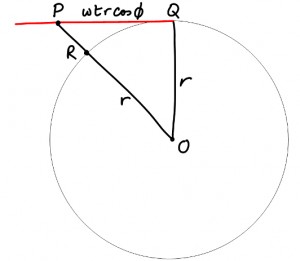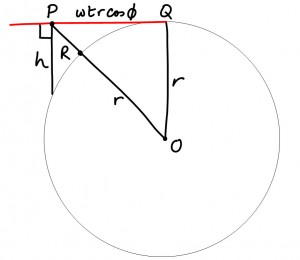Suppose that you were standing perfectly still, and gravity suddenly stopped operating on your body. What would happen? Nothing much, you might think, apart from a queasy feeling of weightlessness. After all, an object won’t start to move unless a force acts on it, and no force is acting on your body.

However, when you stand “still”, in fact you’re travelling in a very large circle at rather high speed, as the Earth turns on its axis and carries you with it. Newton’s 1st Law tells us that things travel in straight lines unless a sideways force acts upon them. The force that keeps tugging you to make you travel in a circle rather than in a straight line is gravity. This means that the moment gravity stops acting on you, you’ll start moving along a straight line (the red line in the diagram) while the ground continues to move in a circular path underneath you (the blue line).
The consequence is that you’ll lose contact with the Earth and float upwards, serenely or otherwise. At least, that’s what it will look like to earthbound observers. But what’s really happening is that the ground is accelerating downwards away from you as it moves on its curved path. Try to remember that as you watch your footprints receding beneath you.
I wondered how fast this would all happen. The answer is: remarkably quickly. I give the geometry later, for those who are interested, but here are some example results for a person standing in Edinburgh, on a latitude of 56° N. Just for now, we’ll pretend that there isn’t any air.
- After 1 second your feet will be 5 millimetres off the ground.
- After 10 seconds you’ll be 53 centimetres off the ground.
- After a minute, you’ll be 19 metres up
- After an hour you’ll be at an altitude of over 68 km (though, being half frozen to death by now, you may be losing interest).
The lower your latitude, the quicker your ascent. At the equator, you’ll rise about three times as fast as in Edinburgh, and at the poles, you won’t lose contact with the ground at all.
Why on earth should I be interested in a situation that is contrived and physically impossible? It’s because it brings home the fact that each of us is constantly moving along a curved path as the Earth rotates. On the equator, it takes only 10 seconds for our trajectory to deviate from a straight line by 1.7 metres (during which time we’ve travelled 465 metres).
Why did I pretend that there isn’t any air? Because the presence of air muddies the waters by adding another force: the upward force of our buoyancy in the air. At low altitudes this force isn’t negligible: it slightly more than doubles the first three figures above. As you rise further and the air gets thinner, it matters less and less. I left it out because I wanted to make the effect of the Earth’s rotation clear.
The question that I’ve just answered is a trimmed-down version of a question that my friend Malcolm and I occupied ourselves with once when we were on a rather long and boring tramp along a glen at the end of a camping trip in the Cairngorms in Scotland. The question we asked then was: what would we observe if gravity suddenly stopped operating altogether? I may return to that subject in a future post.
The geometry
Let the centre of the Earth be at ![]() , the origin, and let the Earth’s radius be
, the origin, and let the Earth’s radius be ![]() and its angular velocity about its own axis be
and its angular velocity about its own axis be ![]() . You are standing at latitude
. You are standing at latitude ![]() and are therefore a distance
and are therefore a distance ![]() from the Earth’s axis. Your linear velocity as you stand still on the rotating Earth will be
from the Earth’s axis. Your linear velocity as you stand still on the rotating Earth will be ![]() , tangential to the Earth’s surface.
, tangential to the Earth’s surface.
 Suppose that gravity stops acting on you at time zero, when you are at point
Suppose that gravity stops acting on you at time zero, when you are at point ![]() . With no gravity acting on you, will now travel in a straight line tangential to the Earth’s surface. The diagram shows the situation from a suitable vantage point, looking sideways on to your direction of travel. We are not looking down on the north pole.
. With no gravity acting on you, will now travel in a straight line tangential to the Earth’s surface. The diagram shows the situation from a suitable vantage point, looking sideways on to your direction of travel. We are not looking down on the north pole.
After a time ![]() , you will have travelled a distance
, you will have travelled a distance ![]() , to point
, to point ![]() .
.
Your altitude is the distance ![]() , where
, where ![]() is the point on the Earth’s surface for which
is the point on the Earth’s surface for which ![]() is directly overhead.
is directly overhead. ![]() lies on
lies on ![]() , the line from
, the line from ![]() to the centre of the Earth. The length of
to the centre of the Earth. The length of ![]() is given directly by Pythagoras’ Theorem in triangle
is given directly by Pythagoras’ Theorem in triangle ![]() : it’s
: it’s ![]() . As
. As ![]() , the altitude of point
, the altitude of point ![]() is
is ![]() . So
. So
![]()
All we need now is ![]() , because the Earth does one full rotation in 86400 seconds, and
, because the Earth does one full rotation in 86400 seconds, and ![]() , because that’s how big the Earth is. We can now choose
, because that’s how big the Earth is. We can now choose ![]() and calculate
and calculate ![]() for any value of
for any value of ![]() .
.
 We can check this answer in two ways. Firstly, we can use the very useful intersecting chords theorem to calculate the distance marked
We can check this answer in two ways. Firstly, we can use the very useful intersecting chords theorem to calculate the distance marked ![]() in the diagram on the right. For small values of
in the diagram on the right. For small values of ![]() , where
, where ![]() , then
, then ![]() should be approximately equal to the your altitude
should be approximately equal to the your altitude ![]() . For values of t of 1, 10, or 60 seconds,
. For values of t of 1, 10, or 60 seconds, ![]() and
and ![]() agree to 4 significant figures. As we expect, as
agree to 4 significant figures. As we expect, as ![]() increases, the agreement gets less good:
increases, the agreement gets less good: ![]() and
and ![]() differ by about 2% after 1 hour.
differ by about 2% after 1 hour.
The second check is to differentiate the expression for ![]() twice with respect to time. The first differentation gives us an expression for the rate of change of
twice with respect to time. The first differentation gives us an expression for the rate of change of ![]() with respect to time, that is, your rate of gain of altitude:
with respect to time, that is, your rate of gain of altitude:
![]()
(Note: to keep things clear, I’ve omitted ![]() , which merely accompanies
, which merely accompanies ![]() everywhere and doesn’t change the conclusions.) Where
everywhere and doesn’t change the conclusions.) Where ![]() , and your motion is purely tangential, this expression for your speed away from the ground should be zero, and where
, and your motion is purely tangential, this expression for your speed away from the ground should be zero, and where ![]() is very large
is very large ![]() , and your motion is purely radial, your speed away from the ground should be
, and your motion is purely radial, your speed away from the ground should be ![]() . Both are true.
. Both are true.
The second differentiation gives us an expression for your upward radial acceleration:
![]()
As it’s not you accelerating, but the ground that is accelerating away from you as it continues on its circular path, this expression for your upwards acceleration should, where ![]() and your path is tangential to the surface, become the same as that for the centripetal acceleration of the ground,
and your path is tangential to the surface, become the same as that for the centripetal acceleration of the ground, ![]() , which it does. In addition, when
, which it does. In addition, when ![]() , and your path is almost radial, the expression for your acceleration should approach zero, which it does.
, and your path is almost radial, the expression for your acceleration should approach zero, which it does.